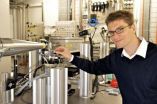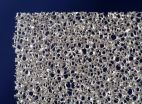(Press-News.org) Osteoporosis, a medical condition in which bones become brittle and fragile from a loss of density, is among the most common diseases in aging bones: In Germany around a quarter of the population aged over 50 is affected. Patients' bone material shrinks rapidly, leading to a significantly increased risk of fracture. In clinical research to date, osteoporosis is diagnosed almost exclusively by establishing an overall reduction in bone density. This approach, however, gives little information about the associated, and equally important, local structure and bone density changes. Franz Pfeiffer, professor for Biomedical Physics at the Technische Universitaet Muenchen (TUM) and head of the research team, has resolved the dilemma: "With our newly developed nano-CT method it is now possible to visualize the bone structure and density changes at high resolutions and in 3D. This enables us to do research on structural changes related to osteoporosis on a nanoscale and thus develop better therapeutic approaches."
During development, Pfeiffer's team built on X-ray computed tomography (CT). The principle is well established – CT scanners are used every day in hospitals and medical practices for the diagnostic screening of the human body. In the process the human body is X-rayed while a detector records from different angles how much radiation is being absorbed. In principle it is nothing more than taking multiple X-ray pictures from various directions. A number of such pictures are then used to generate digital 3D images of the body's interior using image processing.
The newly developed method measures not only the overall beam intensity absorbed by the object under examination at each angle, but also those parts of the X-ray beam that are deflected in different directions – "diffracted" in the language of physics. Such a diffraction pattern is generated for every point in the sample. This supplies additional information about the exact nanostructure, as X-ray radiation is particularly sensitive to the tiniest of structural changes. "Because we have to take and process so many individual pictures with extreme precision, it was particularly important during the implementation of the method to use high-brilliance X-ray radiation and fast, low-noise pixel detectors – both available at the Swiss Light Source (SLS)," says Oliver Bunk, who was responsible for the requisite experimental setup at the PSI synchrotron facilities in Switzerland.
The diffraction patterns are then processed using an algorithm developed by the team. TUM researcher Martin Dierolf, lead author of the Nature article, explains: "We developed an image reconstruction algorithm that generates a high-resolution, three-dimensional image of the sample using over one hundred thousand diffraction patterns. This algorithm takes into account not only classical X-ray absorption, but also the significantly more sensitive phase shift of the X-rays." A showcase example of the new technique was the examination of a 25-micrometer, superfine bone specimen of a laboratory mouse – with surprisingly exact results. The so-called phase contrast CT pictures show even smallest variations in the specimen's bone density with extremely high precision: Cross-sections of cavities where bone cells reside and their roughly 100 nanometer-fine interconnection network are clearly visible.
"Although the new nano-CT procedure does not achieve the spatial resolution currently available in electron microscopy, it can – because of the high penetration of X-rays – generate three-dimensional tomography images of bone samples," comments Roger Wepf, director of the Electron Microscopy Center of the ETH Zurich (EMEZ). "Furthermore, the new nano-CT procedure stands out with its high precision bone density measurement capacity, which is particularly important in bone research." This method will open the door to more precise studies on the early phase of osteoporosis, in particular, and evaluation of the therapeutic outcomes of various treatments in clinical studies.
The new technique is also very interesting for non-medical applications: Further fields of application include the development of new materials in materials science or in the characterization of semiconductor components. Ultimately, the nano-CT procedure may also be transferred to novel, laser-based X-ray sources, such as the ones currently under development at the Cluster of Excellence "Munich-Centre for Advanced Photonics" (MAP) and at the recently approved large-scale research project "Centre for Advanced Laser Applications" (CALA) on the TUM-Campus Garching near Munich.
INFORMATION:
Images of the method: http://mediatum2.ub.tum.de/node?cunfold=997485&dir=997485&id=997485
New computer-tomography method visualizes nano-structure of bones
Advanced imaging for osteoporosis research and materials science
2010-09-22
ELSE PRESS RELEASES FROM THIS DATE:
Physical limitations of breast cancer survivors
2010-09-22
Women who survive breast cancer often suffer from functional limitations that affect motion, strength and dexterity, which may adversely affect all-cause and competing-cause survival but not breast cancer survival, according to a study published online September 22 in The Journal of the National Cancer Institute.
Breast cancer survivors who have functional limitations that affect motion, strength, and dexterity are at the same risk of dying from a recurrence of breast cancer as physically fit survivors, but are more likely to die from other causes.
Breast cancer survivorship ...
Gladstone scientists identify strategy to reduce toxic proteins associated with Alzheimer's disease
2010-09-22
SAN FRANCISCO, CA—September 23, 2010—Scientists at the Gladstone Institute of Neurological Disease (GIND) have uncovered new approaches to reduce toxic proteins in Alzheimer's disease (AD) and other neurodegenerative diseases. The results might lead to new treatments for these diseases.
"We examined a protein called tau that has been strongly implicated in Alzheimer's disease," said Li Gan, PhD, senior author on the study. "Tau forms toxic protein aggregations in the brains of Alzheimer patients."
Tau is a common protein in the central nervous system where it helps ...
Ocean cooling contributed to mid-20th century global warming hiatus
2010-09-22
FORT COLLINS – The hiatus of global warming in the Northern Hemisphere during the mid-20th century may have been due to an abrupt cooling event centered over the North Atlantic around 1970, rather than the cooling effects of tropospheric pollution, according to a new paper appearing today in Nature.
David W. J. Thompson, an atmospheric science professor at Colorado State University, is the lead author on the paper. Other authors are John M. Wallace at the University of Washington, and John J. Kennedy at the Met Office and Phil D. Jones of the University of East Anglia, ...
Cell division typically associated with cancer may also protect the liver from injury
2010-09-22
PORTLAND, Ore. — Researchers at Oregon Health & Science University have discovered that a form of cell division typically associated with cancer called multipolar mitosis can yield diverse, viable cells capable of protecting the liver from injury and poisonous substances, such as pesticides, carcinogens or drugs. Their findings are published online in the journal Nature.
"Our findings show that the liver, which is known to have a tremendous capacity for regeneration, also has an amazing degree of diversity. A better understanding of this process may reveal why some individuals ...
Genetic factor in osteoporosis discovered
2010-09-22
Spanish researchers have confirmed there is a genetic risk factor for osteoporosis and bone fractures. Although more studies are still needed, these findings will make it possible to take preventive measures.
Scientists from the University of Barcelona (UB) have discovered that the genetic variant 677C>T (a single nucleotide polymorphism (SNP) that is very well known in genetic studies) is linked to osteoporotic vertebral fractures, which many women suffer from after the menopause.
"In this genetic variant, the women that displayed a TT combination (or genotype) had ...
Smoking during pregnancy may harm the child's motor control and coordination
2010-09-22
Women who smoke during pregnancy run the risk of adversely affecting their children's coordination and physical control according to a new study from Örebro University, Sweden, published in the Journal of Epidemiology and Community Health.
– Moreover, we discovered that boys' abilities may be affected to a greater extent than those of girls, says Professor Scott Montgomery at Örebro University.
– There is a link between nicotine and testosterone. Nicotine can influence development of the brain and interacts with testosterone particularly during the foetal stage, and ...
A scientific research study analyzes when to buy airline and theater tickets
2010-09-22
Why do airline tickets become more expensive as the travel date approaches whereas theater tickets are sold at half price in Leicester Square on the day of the performance? In their recent article published in the Economic Journal, ("Advance Purchase Discounts versus Clearance Sales"), Professors Marc Möller and Makoto Watanabe from the UC3M Department of Economics have considered the pricing of products that can be purchased in advance, i.e., long before their actual date of consumption. Further examples include seasonal products like the newest skiing equipment or entry ...
An elegant galaxy in an unusual light
2010-09-22
NGC 1365 is one of the best known and most studied barred spiral galaxies and is sometimes nicknamed the Great Barred Spiral Galaxy because of its strikingly perfect form, with the straight bar and two very prominent outer spiral arms. Closer to the centre there is also a second spiral structure and the whole galaxy is laced with delicate dust lanes.
This galaxy is an excellent laboratory for astronomers to study how spiral galaxies form and evolve. The new infrared images from HAWK-I are less affected by the dust that obscures parts of the galaxy than images in visible ...
New luggage inspection methods identify liquid explosives
2010-09-22
To most air travelers, it is an annoying fact of life: the prohibition of liquids in carry-on luggage. Under aviation security regulations introduced in Europe in November 2006, passengers who wish to take liquids such as creams, toothpaste or sunscreen on board must do so in containers no larger than 100 ml (roughly 3.4 fluid oz.). The EU provisions came in response to attempted attacks by terrorist suspects using liquid explosives on trans-Atlantic flights in August 2006. Now, travelers have a reason to hope to see the prohibition lifted. On November 19, 2009, the EU ...
Titanium foams replace injured bones
2010-09-22
The greater one's responsibilities, the more a person grows. The same principle applies to the human bone: The greater the forces it bears, the thicker the tissue it develops. Those parts of the human skeleton subject to lesser strains tend to have lesser bone density. The force of stress stimulates the growth of the matrix. Medical professionals will soon be able to utilize this effect more efficiently, so that implants bond to their patients' bones on more sustained and stable basis. To do so, however, the bone replacement must be shaped in a manner that fosters ingrowth ...
LAST 30 PRESS RELEASES:
Deep neural networks enable accurate pricing of American options under stochastic volatility
Collective risk resonance in Chinese stock sectors uncovered through higher-order network analysis
Does CPU impact systemic risk contributions of Chinese sectors? Evidence from mixed frequency methods with asymmetric tail long memory
General intelligence framework to predict virus adaptation based on a genome language model
Antibiotic resistance is ancient, ecological, and deeply connected to human activity, new review shows
Vapes, pouches, heated tobacco, shisha, cigarettes: nicotine in all forms is toxic to the heart and blood vessels
From powder to planet: University of Modena engineers forge a low-carbon future for advanced metal manufacturing
Super strain-resistant superconductors
Pre-school health programme does not improve children’s diet or physical activity, prompting call for policy changes, study finds
Autumn clock change linked to reduction in certain health conditions
AI images of doctors can exaggerate and reinforce existing stereotypes
Where medicine meets melody – how lullabies help babies and parents in intensive care
We may never be able to tell if AI becomes conscious, argues philosopher
AI video translation shows promise but humans still hold the edge
Deep ocean earthquakes drive Southern Ocean’s massive phytoplankton blooms, study finds
Without campus leftovers to pick through, the beaks of this bird changed shape during the pandemic
High-dose antibiotic does not reduce mortality in tuberculous meningitis
How many insects fly in the sky above the USA?
Could cheese protect your brain health?
Who faces more difficulty recovering from stroke?
Colliding galaxies create the brightest, fastest growing black holes at their center
New BrainHealth research reveals tradeoffs on sleep with cannabis use for chronic pain
Aging-US now on ResearchGate, enhancing visibility for authors and readers
'Molecular glue' stabilizes protein that inhibits development of non-small cell lung cancer
Mount Sinai Health System is recognized in 2025 Chime Digital Health Most Wired survey
From prey to predator: How carnivores spread beneficial fungi
Menopause symptoms may be frequent and have negative effects, according to female endurance athletes
US Congressmembers’ responses on X to mass shooting events differ along party lines
KAIST-UEL team develops “origami” airless wheel to explore lunar caves
Individual genetic differences render some therapies ineffective
[Press-News.org] New computer-tomography method visualizes nano-structure of bonesAdvanced imaging for osteoporosis research and materials science







